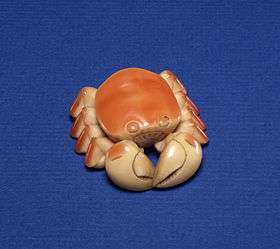Helmeted hornbill
| Helmeted hornbill | |
|---|---|
 | |
| immature male | |
| Scientific classification | |
| Kingdom: | Animalia |
| Phylum: | Chordata |
| Class: | Aves |
| Order: | Bucerotiformes |
| Family: | Bucerotidae |
| Genus: | Rhinoplax Gloger, 1841 |
| Species: | R. vigil |
| Binomial name | |
| Rhinoplax vigil Forster, 1781 | |
| Synonyms | |
|
Buceros vigil | |
The helmeted hornbill (Rhinoplax vigil) is a very large bird in the hornbill family. It is found on the Malay Peninsula, Sumatra and Borneo. The casque (helmetlike structure on the head) accounts for some 11% of its 3 kg weight. Unlike any other hornbill, the casque is almost solid, and is used in head-to-head combat among males.[2] It is a belief among the Punan Bah that a large helmeted hornbill guards the river between life and death.[3]
Description
It has mostly blackish plumage, except that the belly and legs are white and the tail is white with a black band near the tip of each feather. The tail is long and the two central tail feathers are much longer than the others, giving the bird a total length greater than that of any other hornbill species. The body length is 110–120 cm (43–47 in), not counting the tail feathers, which boost the length a further 50 cm (20 in). Males average 3.1 kg (6.8 lb) in weight and females about 2.7 kg (6.0 lb). Although sometimes considered the largest Asian hornbill, they weigh a bit less than the great hornbill (and considerably less than the African ground hornbills).[4]
This species has a bare, wrinkled throat patch, pale blue to greenish in females and red in males. The casque goes from the base of the bill halfway to the tip, where it ends abruptly. It and the bill are yellow; the red secretion of the preen gland covers the sides and top of the casque and the base of the bill, but often leaves the front end of the casque and the distal half of the bill yellow. Unlike other hornbills, the helmeted hornbill's casque is solid, and the skull including the casque and bill may constitute 10 percent of the bird's weight.
Call
The call is a series of loud, intermittent barbet-like hoots, sometimes double-toned and over two dozen in number, which gradually accelerates to culminate in a cackle reminiscent of laughter.
Habits
This bird eats mostly fruit, especially figs. It may also use the casque as a weighted tool to dig into rotten wood and loose bark in search of insects and similar prey. Unlike many fruit-eating hornbills, it is sedentary, and pairs maintain a territory. Males fight over territory on the wing, ramming each other with their casques.
Status
After ongoing hunting pressure and habitat loss, the helmeted hornbill was uplisted from near threatened to critically endangered on the IUCN Red List of Threatened Species in 2015. It is listed in Appendix I of CITES.
Ivory casque

The casque is the source of hornbill ivory, a valuable carving material. Indigenous peoples also use the central tail feathers to decorate dancing cloaks and head-dresses. Historically, the casque was also used by carvers in China and Japan.[5]
References
- ↑ BirdLife International (2015). "Rhinoplax vigil". IUCN Red List of Threatened Species. Version 2015.4. International Union for Conservation of Nature. Retrieved 25 November 2015.
- ↑ "The bird that's more valuable than ivory". Magazine. BBC News. 12 October 2015. Retrieved 19 October 2015.
- ↑ Archived February 4, 2012, at the Wayback Machine.
- ↑
- ↑ BBC Magazine (12 Oct 2015). "The bird that's more valuable than ivory". BBC. Retrieved 13 Oct 2015.
- Perrins, Christopher (ed.) (2003). Firefly Encyclopedia of Birds. Firefly Books. ISBN 1-55297-777-3.
- Kemp, Allen (1994). Hornbills: Bucerotidae. Oxford University Press. ISBN 0-19-857729-X. Quoted at
